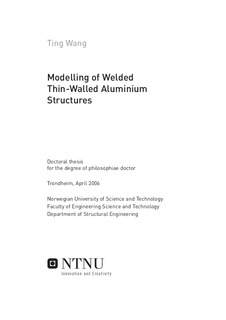| dc.contributor.author | Wang, Ting | nb_NO |
| dc.date.accessioned | 2014-12-19T11:57:55Z | |
| dc.date.available | 2014-12-19T11:57:55Z | |
| dc.date.created | 2007-05-15 | nb_NO |
| dc.date.issued | 2006 | nb_NO |
| dc.identifier | 122367 | nb_NO |
| dc.identifier.isbn | 82-471-7906-7 | nb_NO |
| dc.identifier.uri | http://hdl.handle.net/11250/236374 | |
| dc.description.abstract | This thesis aims to develop a comprehensive methodology for capacity prediction of thin-walled welded aluminium structures. Through material testing, model choice and calibration, numerical simulations and experimental verification, a procedure and a combination of modelling techniques using shell elements were obtained for such structures.
Experimental and numerical studies were performed to investigate the structural capacity of quasi-statically loaded fillet-welded connections. The data of two other series of experiments were adopted from a previous study and were used to verify the modelling methodology developed in this study. These experiments are beam-tocolumn joints subjected to tension and welded members subjected to four-point bending.
In the numerical study, the yielding and work hardening parameters for the weld, HAZ and base material were identified through material tests in the current study and available data from previous experiments. Shell elements in LS-DYNA are used throughout this thesis. With relatively large elements, the numerical analyses were generally found efficient and accurate in prediction of ultimate load, but structural ductility was over-estimated. When using smaller elements, the results were seen to be mesh-dependent and fail to predict the structural performance properly. This problem was solved by introducing a nonlocal approach to plastic thinning in the HAZ and weld. Several case studies showed that mesh sensitivity was greatly reduced. Techniques of representing the thickness variation in fillet welds, contact between coarse and dense meshed regions were used and were shown to improve the analyses in terms of efficiency or accuracy.
A simple analytical method was introduced to compute the mechanical response of a welded aluminium sheet under uniaxial tensile loading. Despite certain limitations it predicts the performance of the sheet reasonably well. These analyses gave a rapid engineering assessment to the influence of HAZ modelling on prediction of the structural capacity of a welded connection, especially with respect to its ductility. | nb_NO |
| dc.language | eng | nb_NO |
| dc.publisher | Fakultet for ingeniørvitenskap og teknologi | nb_NO |
| dc.relation.ispartofseries | Doktoravhandlinger ved NTNU, 1503-8181; 2006:78 | nb_NO |
| dc.title | Modelling of welded thin-walled aluminium structures | nb_NO |
| dc.type | Doctoral thesis | nb_NO |
| dc.contributor.department | Norges teknisk-naturvitenskapelige universitet, Fakultet for ingeniørvitenskap og teknologi, Institutt for konstruksjonsteknikk | nb_NO |
| dc.description.degree | PhD i konstruksjonsteknikk | nb_NO |
| dc.description.degree | PhD in Structural Engineering | en_GB |
